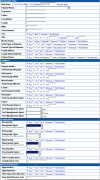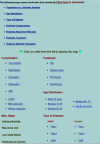Design and development of a web-based Saudi National Diabetes Registry
- PMID: 21129356
- PMCID: PMC3005071
- DOI: 10.1177/193229681000400635
Design and development of a web-based Saudi National Diabetes Registry
Abstract
Background: Given that diabetes is an extremely common disorder in Saudi Arabia, the National Diabetes Registry was designed by King Saud University Hospital Diabetes Center in collaboration with King Faisal Specialist Hospital & Research Center, Riyadh, Saudi Arabia, in the year 2001. The aim of the registry is to identify risk factors related to diabetes and to provide statistics to public health programs and health care professionals for use in planning and evaluation. The registry was designed to provide information on the extent and nature of specific types of diabetes, diabetes complications, and treatment of diabetes in the Kingdom. The registry has been available since 2001, with major collaborations from 26 hospitals as part of Phase I in which 100,000 patient data is to be collected on a regional level from Ar-Riyadh before extending the program to other regions of Saudi Arabia.
Methods: The web application was designed using relational database techniques along with on-line help topics to assist users to get acquainted with application functionalities. All Internet forms were designed with validation checks and appropriate messages to ensure quality of data. The security measures established within the application ensure that only authorized users can gain access to the functionalities of the registry at allowed times. Administrative features were designed to manage the registry-related operations easily.
Results: The diabetes registry has been in operation for almost 10 years, and around 67,000 patients have been registered to date. The Web-application offers an anytime-anywhere access to the registry's data, removing geographical boundaries and allowing the national registry to provide real-time data entry, updates, reporting, and mapping functionalities more easily.
Conclusion: Merging related information in the form of databases can provide improved health care operations through instant access to data, ease of managing complex data structures, and creation of reports to be used by health care planners and hospital administrators.
© 2010 Diabetes Technology Society.
Figures























Similar articles
-
A Web-based interactive diabetes registry for health care management and planning in Saudi Arabia.J Med Internet Res. 2013 Sep 9;15(9):e202. doi: 10.2196/jmir.2722. J Med Internet Res. 2013. PMID: 24025198 Free PMC article.
-
Design and development of an Internet registry for congenital heart defects.Teratology. 2002 Feb;65(2):78-87. doi: 10.1002/tera.10016. Teratology. 2002. PMID: 11857509
-
Building a cloud-based data sharing model for the Saudi national registry for implantable medical devices: Results of a readiness assessment.Int J Med Inform. 2018 Oct;118:113-119. doi: 10.1016/j.ijmedinf.2018.08.005. Epub 2018 Aug 3. Int J Med Inform. 2018. PMID: 30153916
-
Current Status of Knowledge and Awareness of Diabetes Mellitus in Saudi Arabia.Curr Diabetes Rev. 2021;17(5):e101220186818. doi: 10.2174/1573399816999201012200841. Curr Diabetes Rev. 2021. PMID: 33045977 Review.
-
Diabetes Mellitus in Saudi Arabia: A Review of the Recent Literature.Curr Diabetes Rev. 2016;12(4):359-368. doi: 10.2174/1573399811666150724095130. Curr Diabetes Rev. 2016. PMID: 26206092 Review.
Cited by
-
Health informatics publication trends in Saudi Arabia: a bibliometric analysis over the last twenty-four years.J Med Libr Assoc. 2021 Apr 1;109(2):219-239. doi: 10.5195/jmla.2021.1072. J Med Libr Assoc. 2021. PMID: 34285665 Free PMC article.
-
Design, development and evaluation of registry software for upper limb disabilities.Healthc Technol Lett. 2024 Dec 12;11(6):496-503. doi: 10.1049/htl2.12115. eCollection 2024 Dec. Healthc Technol Lett. 2024. PMID: 39720749 Free PMC article.
-
Establishing the Saudi pediatric and youth diabetes registry: initial data and challenges.Sudan J Paediatr. 2024;24(1):10-20. doi: 10.24911/SJP.106-106-1715756287. Sudan J Paediatr. 2024. PMID: 38952627 Free PMC article.
-
Diabetes mellitus research in Saudi Arabia: A bibliometric study (2010-2021).J Family Med Prim Care. 2023 Jun;12(6):1038-1049. doi: 10.4103/jfmpc.jfmpc_1889_22. Epub 2023 Jun 30. J Family Med Prim Care. 2023. PMID: 37636176 Free PMC article. Review.
-
International Comparison of Thalassemia Registries: Challenges and Opportunities.Acta Inform Med. 2019 Mar;27(1):58-63. doi: 10.5455/aim.2019.27.58-63. Acta Inform Med. 2019. PMID: 31213746 Free PMC article.
References
-
- Ledward RS. Initial findings in a new obstetric unit in Saudi Arabia. Trop Doct. 1982;12:63. - PubMed
-
- Bacchus RA, Bell JR, Madkour M, Kilshaw The prevalence of diabetes mellitus in male Saudi Arabs Diabetologia. 1982;23:330. - PubMed
-
- Al-Nuaim AR. Prevalence of glucose intolerance in urban and rural communities of Saudi Arabia. Diabet Med. 1997;14:595–602. - PubMed
-
- Al-Nozha MM, Al-Matouq MA, Al-Mazrou YY, Al-Harthi SS, Arafah MR, Khalil MZ, Khan NB, Al-Khadra A, Al-Marzouki K, Nouh MS, Abdullah M, Attas O, Al-Shahid MS, Al-Mobeireek A. Diabetes mellitus in Saudi Arabia. Saudi Med J. 2004;25:1603–1610. - PubMed
-
- Rivest R. MIT Laboratory for Computer Science and RSA Data Security, Inc. RFC 1321 - The MD5 Message-Digest Algorithm. Available at: http://www.faqs.org/rfcs/rfc1321.html.
MeSH terms
LinkOut - more resources
Full Text Sources
Medical
Research Materials

